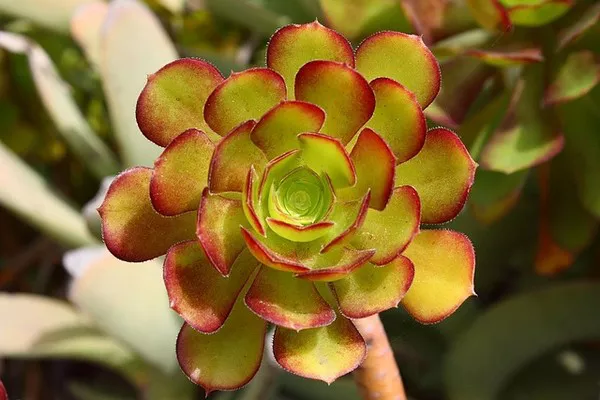Succulents, with their captivating shapes and vibrant colors, have become a favorite among plant enthusiasts and novices alike. One of the most appealing characteristics of these desert-dwelling plants is their ability to store water in their leaves, stems, or roots, allowing them to thrive in arid conditions. However, despite their water-storing prowess, succulents still require proper watering to stay healthy. In this comprehensive guide, we will delve into the intricacies of watering small succulents, covering everything from understanding their unique needs to providing practical tips for optimal care.
Factors Influencing Watering Frequency
Several factors influence how often small succulents should be watered. Understanding these variables is crucial for maintaining the health and vitality of your plants.
1. Species/Variety
Succulents encompass a vast array of species and varieties, each with its own specific watering requirements. While some varieties, such as Haworthia and Gasteria, prefer more frequent watering, others like Echeveria and Sedum thrive on infrequent watering. It’s essential to research the specific needs of your succulent species to ensure you meet their individual requirements.
2. Potting Mix
The type of soil in which succulents are planted plays a significant role in their watering needs. Succulents thrive in well-draining soil that allows excess water to flow out easily, preventing root rot and waterlogging. A mix of coarse sand, perlite, and gritty soil is ideal for promoting drainage and preventing water retention.
3. Pot Size and Material
The size and material of the pot can impact the watering frequency of small succulents. Terracotta pots, with their porous nature, allow for better airflow and water evaporation, leading to faster drying times. On the other hand, plastic pots retain moisture for longer periods, requiring less frequent watering. Additionally, the size of the pot relative to the size of the plant can influence how quickly the soil dries out, with smaller pots drying out faster than larger ones.
4. Climate and Season
Environmental factors such as temperature, humidity, and sunlight exposure also affect the watering needs of succulents. In hot, dry climates, succulents may require more frequent watering to prevent dehydration, while in cooler, more humid environments, watering can be less frequent. Similarly, seasonal changes can impact watering frequency, with succulents generally requiring less water during their dormant period in winter.
Signs of Overwatering and Underwatering
Recognizing the signs of overwatering and underwatering is crucial for maintaining the health of your small succulents.
Overwatering can lead to root rot, fungal infections, and wilting. Signs of overwatering include mushy, yellowing leaves, soggy soil, and a foul odor emanating from the potting mix. If you notice these symptoms, reduce watering frequency and ensure proper drainage to allow the soil to dry out between waterings.
Underwatering, on the other hand, can cause shriveled leaves, wilting, and discoloration. If your succulent appears dehydrated and the soil is dry to the touch, increase watering frequency and ensure thorough hydration.
How to Properly Water Small Succulents
Proper watering techniques are essential for the health and longevity of small succulents. Follow these steps to ensure your plants receive the hydration they need without risking overwatering.
1. Watering Techniques
The “soak and dry” method is widely recommended for watering succulents. This involves thoroughly saturating the soil until water drains out of the bottom of the pot, ensuring that the roots receive adequate moisture. Allow the soil to dry out completely between waterings to prevent waterlogged conditions.
Alternatively, you can use a bottom-up watering technique by placing the pot in a shallow tray of water and allowing the soil to absorb moisture through the drainage holes. Once the soil is adequately hydrated, remove the pot from the water and allow excess moisture to drain away.
2. Determining Soil Moisture
To determine when to water your small succulents, insert your finger into the soil up to the first knuckle. If the soil feels dry, it’s time to water. Avoid watering if the soil still feels moist, as overwatering can lead to root rot and other complications.
You can also use a moisture meter to gauge soil moisture levels more accurately. These handy devices provide instant feedback on the moisture content of the soil, allowing you to adjust your watering schedule accordingly.
3. Water Quality
The quality of water used for watering succulents can impact their health and growth. Ideally, use distilled or rainwater to avoid mineral buildup and chemicals present in tap water. If tap water is your only option, allow it to sit out for 24 hours to allow chlorine and other additives to dissipate before watering your plants.
Additional Tips for Succulent Care
In addition to proper watering, there are several other factors to consider when caring for small succulents.
1. Light Requirements: Succulents thrive in bright, indirect sunlight. Place them near a south-facing window or provide supplemental grow lights to ensure they receive adequate light for healthy growth.
2. Fertilization: While succulents are not heavy feeders, occasional fertilization during the growing season can promote robust growth and vibrant colors. Use a balanced, water-soluble fertilizer diluted to half strength and apply it sparingly to avoid overfertilization.
3. Propagation: Succulents are easy to propagate from stem or leaf cuttings. Allow the cuttings to callus over for a few days before planting them in well-draining soil. Keep the soil lightly moist until roots develop, then gradually transition to regular watering.
Conclusion
By understanding the unique watering needs of small succulents and providing them with the proper care and attention, you can enjoy healthy, thriving plants that add beauty and charm to any space. With the guidance provided in this article, you’ll be well-equipped to nurture your succulents and watch them flourish for years to come.


